Abstract
Modern cities are rapidly evolving in terms of urban morphology, driven by exponential population growth that accelerates the urbanisation process. The changes in land use have increased urban area and density, intensifying the urban heat island (UHI) effect, which poses one of the biggest threats to human health and well-being, especially in metropolitan regions. One of the most effective strategies to counter urban heat is the implementation of green infrastructure and the use of suitable building materials that help reduce heat stress. However, access to green spaces and the affordability of efficient building materials are not the same among citizens. This paper aims to identify the socio-economic characteristics of communities in Melbourne, Australia, that contribute to their vulnerability to urban heat under local conditions. This study employs remote sensing and geographical information systems (GIS) to conduct a macro-scale analysis, to investigate the correlation between urban heat patterns and socio-economic characteristics, taking into account factors such as vegetation cover, built-up areas, and land use types. The results from the satellite images and the geospatial data reveal that Deer Park, located in the western suburbs of Melbourne, has the highest land surface temperature (LST) at 32.54 °C, a UHI intensity of 1.84 °C, a normalised difference vegetation index (NDVI) of 0.11, and a normalised difference moisture index (NDMI) of −0.081. The LST and UHI intensity indicate a strong negative correlation with the NDVI (r = −0.42) and NDMI (r = −0.6). In contrast, the NDVI and NDMI have a positive correlation with the index of economic resources (IER) with r values of 0.29 and 0.24, indicating that the areas with better finance resources tend to have better vegetation coverage or plant health with less water stress, leading to lower LST and UHI intensity. This study helps to identify the most critical areas in the Greater Melbourne region that are vulnerable to the risk of urban heat and extreme heat events, providing insights for the local city councils to develop effective mitigation strategies and urban development policies that promote a more sustainable and liveable community.
1. Introduction
The urban morphology of many cities around the globe has been experiencing drastic changes due to ongoing urbanisation in response to the rapid growth of populations. Nowadays, more than half of the world’s population (55%) is living in urban areas, with the world population predicted to reach 8.5 billion in 2030 [1,2]. Under the continuous pressures of an increasing population, there is an urgent need for newly developed residential properties to accommodate the housing demand for residents [3]. According to the National Housing Finance and Investment Corporation (NHFIC) reports, the predicted total number of Australian households will increase from 10.7 million in 2022 to 12.6 million in 2033 [4]. Among all the state capital cities in Australia, Melbourne has the largest increase by 167,500 people [5]. The city will have to expand by transforming the existing farmlands, green wedges, and natural landscape into residential areas, along with other infrastructure that is required to support the newly developed neighbourhoods [6]. In the metropolitan region that lacks land to further expand, the existing low-density housing would be replaced by high-density high-rise apartments [7].
The growth of urban areas and density are the main causes of the urban heat island (UHI) effect. The UHI effect is a phenomenon that the temperature in the city area is significantly higher than in the rural area [8]. Cities under the severe UHI result in having a higher energy consumption due to the demand for heating, ventilation, and air conditioning (HVAC) to maintain thermal comfort [9]. The overreliance on the HVAC system created waste heat and carbon emissions, which eventually contributed to global warming that escalated the intensity of the UHI and heat waves [10].
In fact, the UHI intensity is easily affected by the existing built environment, land use type, and vegetation coverage. Many studies have pointed out that areas with lower vegetation result in a higher land surface temperature due to the building materials absorbing more solar radiation during the day [11,12,13]. This is supported by a study in Philadelphia; with a record mean surface temperature of 28.42 °C, commercial land use was the hottest (30.41 °C) and park/open space was the coldest (23.99 °C), while high-density residential was only one degree different from the mean temperature [14]. Increasing urban green spaces and blue-green infrastructures are effective in mitigating the UHI effect, as vegetation provides evapotranspiration, and trees provide shading to reduce the surface temperature [15,16]. Therefore, many cities around the world have rising awareness to increase blue-green infrastructure, such as a green roof, green wall, urban park, and tree canopy, to reduce the UHI intensity [11,17,18]. However, the availability of green space and blue-green infrastructure is not always distributed equally for every resident in the city to access.
1.1. Socio-Economic Factors That Reduce Green Space Accessibility of Vulnerable Communities
The accessibility to urban green spaces and blue-green infrastructures depends on the socio-economic characteristics of the community. Studies show that areas with higher income and property prices usually have better accessibility to quality green space, which introduces environmental and socio-economic inequalities [19,20,21,22]. However, the areas that have higher UHI intensity are usually the areas that have less accessibility to green space, while the population within these areas usually has a lower socio-economic status [23,24]. A study observed that a space-poor household in Hong Kong tends to have a higher frequency to visit urban parks during summer, to reduce the high energy cost for space cooling at home [25]. In the US, areas with high-density residential areas with low income contributed to the high heat vulnerability, due to the higher population of vulnerable groups below 15 and above 65 years old, who largely occupy low-quality housing [26].
It is noticeable that certain groups of population in society are more vulnerable to the risk of heat stress. Thermal comfort is usually associated with the human metabolic rate, which is affected by the individual features of race, gender, age, and weight [27]. Suggested by M., Rachel and Lara (2013) [28], the heat risk can relate to racial/ethnic distribution due to the land cover associated with residential segregation within each racial/ethnic group. Mushangwe et al. (2021) [29] attempted to explore the relationship between ethnicity and green space availability, but were not able to conclude due to limitations. Pearsall (2017) [14] concluded that the proportion of families in poverty and people of colour is higher in hot spots, where the median household income was nearly USD 12,000 less than outside the hot spot with a 5% lower labour force.
Therefore, it is crucial to analyse the socio-economic characteristics of individual areas in the city premises, to identify the communities that are more vulnerable and have higher risks under urban heat or extreme heat events. Such analysis on a macro-city scale can be achieved by using a combination of remote sensing and geographical information systems.
1.2. Analysis of Urban Heat Patterns Using Remote Sensing and Geographical Information Systems
To understand the impacts of city morphology acting toward the UHI pattern, it is necessary to analyse on a large scale that covers the entire city region. However, not every method and tool for urban heat study is suitable for a macro-city-scale study [30]. As Kim and Brown (2021) [31] pointed out, the limitation of using air temperature data to analyse the UHI often depends on the interaction between meteorological data and urban geometries at each measurement point. Therefore, remote sensing technology using satellite orbiting around the globe is relatively practical when conducting large city-scale analysis to identify areas that have high risk under extreme heat [32]. One of the common remote sensing tools used is the Landsat 8 satellite. The Landsat 8 satellite image allows for observing the relationship between the land surface temperature (LST), normalised difference built-up index (NDBI), normalised difference vegetation index (NDVI), and normalised difference moisture index (NDMI) [33,34,35,36]. The combination of using remote sensing and geographical information systems (GIS) creates the possibility to develop models that allow identifying the relationship between urban form and heat island parameters [37,38]. Geospatial data can be integrated into a grid-based assessment framework on heat risk by mapping urban socio-economic vulnerability [39]. For example, a study conducted by Viju, Nambiar, and Firoz C. (2023) [40] demonstrated the application of GIS by using the satellite images for calculating the NDVI in combination with the digitisation of Land Use Land Cover Change (LULC) to evaluate the impact of LULC toward agriculture, forest, and wetland/water bodies due to urbanisation. The NDVI is also associated with drought conditions and plant health. Mentioned by Imtiaz et al. (2024), the soil moisture values varied depending on the growth stage [41]. Therefore, the NDMI was introduced to provide information on the water stress and soil moisture level, to help analyse the connection between the NDMI, NDVI, and LST.
In Australia, the combination of GIS and remote sensing helps in developing the correlation between urban heat, vegetation coverage, and potential relationships with socio-economic factors. For example, the study conducted by Sidiqui, Tariq, and Ng (2022) [42] used a multivariate regression model to establish the relationship between population density with the surface urban heat island (SUHI). Different socio-economic variables have also been developed that allow for comprehensive correlation studies, such as the heat vulnerability index (HVI) and green space accessibility, to demonstrate the association between the UHI and socio-economic status of residents [43,44].
Melbourne, as the capital city of Victoria state in Australia, is experiencing a housing crisis as the population has reached a record 5,350,705 people in the financial year ending June 2024 [45]. It is expected that the city will be expanded and denser in the future. This study aims to provide a better understanding of the interconnection between urban heat and socio-economic factors related to urban morphology, specifically the vegetation coverage and land use types. By using the combination of remote sensing technology and GIS, macro-scale geospatial data can be collected to conduct the correlation analysis between the variables. This macro-scale study will help the local authorities to identify the vulnerable communities that experienced higher risk under the threat of urban heat and extreme heat events, with tangible results that encourage the city councils and urban developers to improve green space accessibility by deploying blue-green infrastructure strategically in the hot spot areas.
2. Methods
This research uses the geographic information system (GIS) software, ArcGIS Pro (version 3.4), to conduct a macro-scale correlation analysis based on three geospatial datasets extracted from different organisations. The first set of data are the remote sensing images collected by the Landsat 8 satellite (United States Geological Survey, VA, USA) [46]. The satellite data can be processed by the ArcGIS Pro software to obtain the following indicators: the normalised difference vegetation index (NDVI), normalised difference built-up index (NDBI), the normalised difference moisture index (NDMI), land surface temperature (LST), and urban heat island (UHI) intensity.
The second set of data used the latest available census data collected by the Australian Bureau of Statistics (ABS) in 2021, to help identify the socio-economic characteristics using the Socio-Economic Indexes for Australia (SEIFA) scores and ranking of individual areas based on the Statistical Area Level 2 (SA2). These indexes can be visualised in digital maps using the ArcGIS Pro with geospatial data in each SA2 zone.
The third dataset is used to identify the land zone and land use types according to the Department of Environment, Land, Water and Planning (DELWP) planning zone scheme in 2021. The workflow of these three datasets using ArcGIS Pro software for correlation analysis is illustrated in Figure 1 below.
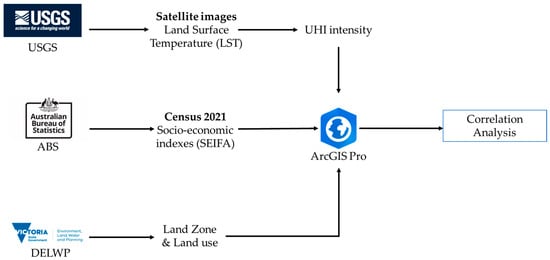
Figure 1.
Framework of the proposed use of the geographic information system ArcGIS Pro to conduct correlation analysis of three individual geospatial datasets.
2.1. Study Area
To conduct a macro-scale analysis, the selected study area focuses on the Greater Melbourne region, which contains 361 suburbs according to the SA2, that is governed by 34 corresponding city councils. These areas cover 9992.608 km2 of land, extending from latitude 37.636823 S to 38.500788 S, and longitude 144.333391 E to 144.889324 E. Melbourne is under a temperate oceanic climate (Cfb) according to the Koppen–Geiger climate categories, which experiences a mild temperate winter and fully humid warm summer [47]. The study area is highlighted with the red boundary line in Figure 2 with the Landsat 8 images underlays.
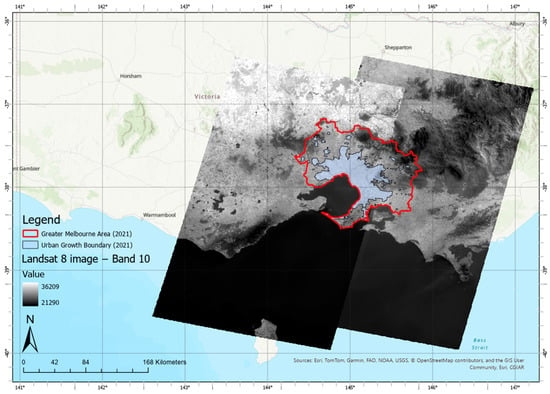
Figure 2.
Study location of Melbourne, Victoria, with four satellite images on a scale of 1:2,500,000 (Sources: Esri, TomTom, Garmin, FAO, NOAA, USGS@ OpenStreetMap contributors, and the GIS User Community, Esri, CGIAR).
2.2. Using the Landsat 8 Satellite Image for Analysis
The Landsat 8 is a satellite developed by the National Aeronautics and Space Administration (NASA) and launched to the atmosphere back in 2013 [48]. There are two major instruments that were equipped on the Landsat 8 satellite: the Operational Land Imager (OLI) and the Thermal Infrared Sensor (TIRS) Collection 2 Level 1 (Landsat 8 OLI/TIRS C2 T1). The OLI captures the data from nine different spectral bands from Band 1 to Band 9, and the TLIRS is divided into two bands, Band 10 and Band 11. Each of the bands represented the electromagnetic wavelength spectrum, which is summarised in the following Table 1. For this study, the images of Band 4 (Red), Band 5 (NIR), Band 6 (SWIR 1), and Band 10 (TIRS 1) were used to calculate and generate images for the analysis of the following values: NDVI, NDBI, LST, and UHI.

Table 1.
Landsat 8 OLI/TIRS bands summary [48].
The Landsat 8 satellite images can be downloaded from the USGS EarthExplorer [46]. There are a few criteria applied when selecting the satellite images that are appropriate and relevant to this study:
- Firstly, the satellite images were chosen between 1 January 2021 and 31 December 2021. Although there are more recent satellite images that can be obtained from the USGS, the correlation analysis also involves the use of the 2021 ABS Census and the DEWLP planning zone scheme 2021; hence, the satellite images from 2021 are considered more relevant to the other datasets.
- Secondly, the cloud cover conditions are limited to a maximum of 2% to avoid any excessive cloud that might block or reflect certain wavelengths, hence influencing the accuracy of the results [49].
- Thirdly, the satellite images need to have the orbit path and row that allow coverage over the selected study area of the Greater Melbourne region; therefore, only images with orbit paths between 92 and 93, and orbit rows between 86 and 87 can fulfil the requirements.
Based on the above criteria, four sets of satellite images were selected from USGS EarthExplorer, with the details summarised in Table 2 below. These four satellite images were further utilised with the geoprocessing method in ArcGIS Pro software, named “Mosaic Data Management Tool”, which allows merging multiple existing raster image datasets into a single raster dataset. Due to the limited satellite orbit, there was a lack of raster images that could cover the entire study area on the same day; this mosaic data management tool was used to combine the satellite images from two different dates into one single map in this study.

Table 2.
Summary of specification of the Landsat 8 satellite image datasets used in this study.
The steps involved in the UHI intensity calculations are presented below in Figure 3. The conversion of Digital Numbers (DNs) into physical units is based on the Landsat 8 Data Users Handbook [50]:
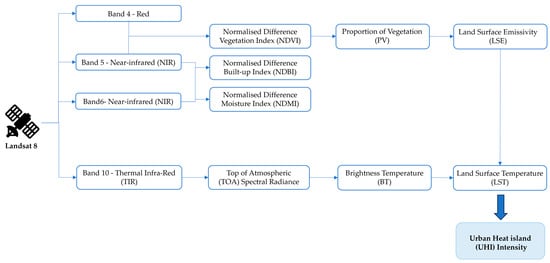
Figure 3.
The algorithm workflow to calculate the urban heat island (UHI) intensity using Landsat 8 satellite image data.
- Step 1: Conversion to Top-of-Atmospheric (TOA) Spectral Radiance.
Using the radiance rescaling factor, the thermal infrared Digital Numbers can be converted to TOA spectral radiance.
where
= TOA spectral radiance [W/m2.sr.μm];
= radiance multiplicative Band 10 is 3.342 × 10−4;
= radiance add Band 10 is 0.1;
= quantised and calibrated standard product pixel values [DN];
= correction value for stray light error is 0.29 W/m2/sr/um (~2.1 K).
- Step 2: Conversion to TOA spectral radiance to Brightness Temperature (BT)
Spectral radiance data can be converted to top-of-atmosphere brightness temperature using the thermal constant values in metadata file.
where
= TOA brightness temperature [°C];
= TOA spectral radiance [W/m2.sr.μm];
= constant Band 10 is 774.8853;
= constant Band 10 is 1321.0789.
- Step 3: Normalised Difference Vegetation Index (NDVI)
The normalised difference vegetation index (NDVI) is the calculated ratio of reflectivity difference between the visible and near-infrared (NIR) wavelength, Landsat 8 Band 4 represents the visible red band, and Band 5 represents the NIR band [51].
where
= DN values from the RED band;
= DN values from near-infrared band.
The NDVI is a sensitivity indicator with values ranging between −1 and +1 based on the green vegetation growth conditions and amount [49].
- Step 4: Calculating the Proportion of Vegetation, PV
= Proportion of Vegetation;
= DN values from NDVI raster image;
= minimum DN values from NDVI image;
= maximum DN values from NDVI image.
- Step 5: Calculating the Land Surface Emissivity (LSE)
Land Surface Emissivity (LSE) is the average emissivity of an element on the surface of the Earth calculated from the NDVI value.
where
= Land Surface Emissivity;
= Proportion of Vegetation;
0.986 is the correction value of the equation.
- Step 6: Calculate the Land surface temperature (LST)
The land surface temperature (LST) is the radiative temperature, which is calculated using the TOA brightness temperature (BT), wavelength of emitted radiance, and Land Surface Emissivity (LSE).
where
= top-of-atmosphere brightness temperature [°C];
= wavelength of emitted radiance;
= Land Surface Emissivity;
= 1.4388 × 10−2 mK = 14388 [μmK];
= Planck’s Constant = 6.626 × 10−34 [Js];
= Boltzmann constant = 1.38 × 10−23 [JK];
= velocity of light [m/s].
- Step 7: Calculate the UHI intensity
To calculate the UHI intensity, the study used the land surface temperature minus the mean of the LST from the selected area divided by the standard deviation (SD), which can be formulated as follows:
where
= LST;
= mean of LST of the study area;
= standard deviation.
In order to find out the LST for this equation, the calculation of the land surface temperature used the algorithm developed from the ERDAS IMAGINE 2014 [51].
2.2.1. Normalised Difference Built-Up Index (NDBI)
The NDBI is an indicator to illustrate the spatial distribution of the built-up area density in unit pixels, which has a value range between −1 and 1 [34].
“The Normalized Difference Built-up Index (NDBI) uses the NIR and SWIR bands to emphasise manufactured built-up areas. It is ratio-based to mitigate the effects of terrain illumination differences as well as atmospheric effects”.
where
= normalised differential built-up index;
= DN values from the shortwave-infrared band;
= DN values from the near-infrared band.
2.2.2. Normalised Difference Moisture Index (NDMI)
The NDMI, also known as the normalised difference water index (NDWI), is used to determine the vegetation water content or the water stress in the soil. It can be calculated as a proportion between the NIR and SWIR [36,52].
where
= normalised differential moisture index;
= DN values from the shortwave-infrared band;
= DN values from the near-infrared band.
2.3. Land Zone and Land Use Categories
Figure 4 shows the land use type according to the DELWP planning zone scheme 2021, which contains 27 main categories and 177 subcategories. Figure 4 features a variety of land use and specific structures ranging from the high-density high-rise apartments, mix-use hotels apartments, office and commercial buildings in Melbourne CBD, Melbourne Airport, port of Melbourne near the Yarra River exit to Port Philips Bay, the industrial zone in the west and southeast, and the new expanded low-density residential at the northern–western suburbs.
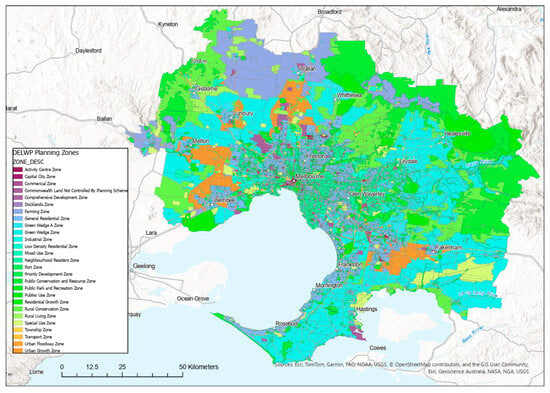
Figure 4.
Illustration of land use type based on the DELWP planning zone scheme 2021 on a scale of 1:750,000.
2.4. Socio-Economic Factors That Contribute to Urban Heat
Socio-economic Indexes for Australia (SEIFA) are created by the ABS to score and rank the area according to the corresponding socio-economic advantages and disadvantages based on the census data that are conducted every five years [53]. The SEIFA have a collection of four indexes, which have different focuses on the socio-economic characteristics in an area; these four indexes are the following:
- Index of Relative Socio-economic Disadvantage (IRSD) focuses on the economic and social conditions of people and households within an area and measures only the relative disadvantage.
- Index of Relative Socio-economic Advantage and Disadvantage (IRSAD) is similar to the IRSD in that it focuses on the economic and social conditions of people and households within an area, but measures both the advantages and disadvantages.
- Index of Economic Resources (IER) focuses on the financial aspects by summarising variables related to income and housing.
- Index of Education and Occupation (IEO) reflects the educational and occupational level of communities.
The SEIFA score is an area-based measure where the deciles are calculated by dividing the areas into ten groups of equal size, which initially uses the variable as proportions at the Statistical Area Level 1 (SA1) [54]. In this study, the SEIFA was studied with the higher-level geographical area SA2, which was calculated using population-weighted averages of the SA1 scores, to determine the decile ranking of each index, with the lower the ranking representing a greater disadvantage. The lowest ranking is 1 and the highest ranking is 10. Some areas do not have a ranking due to very low or no population/household to provide enough data for calculating the ranking score. The data of the SEIFA are available on the ABS website and Figure 5 displays the digitalised maps generated from the ArcGIS Pro software that focus on the Greater Melbourne region.
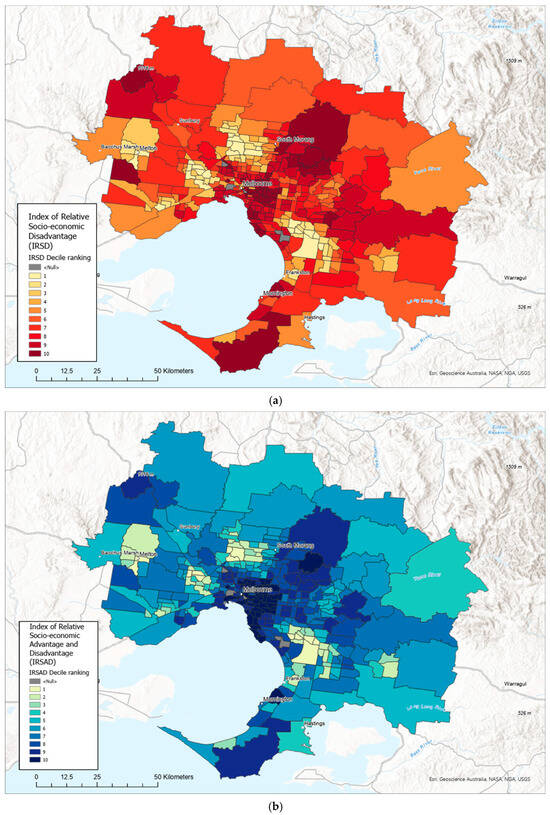
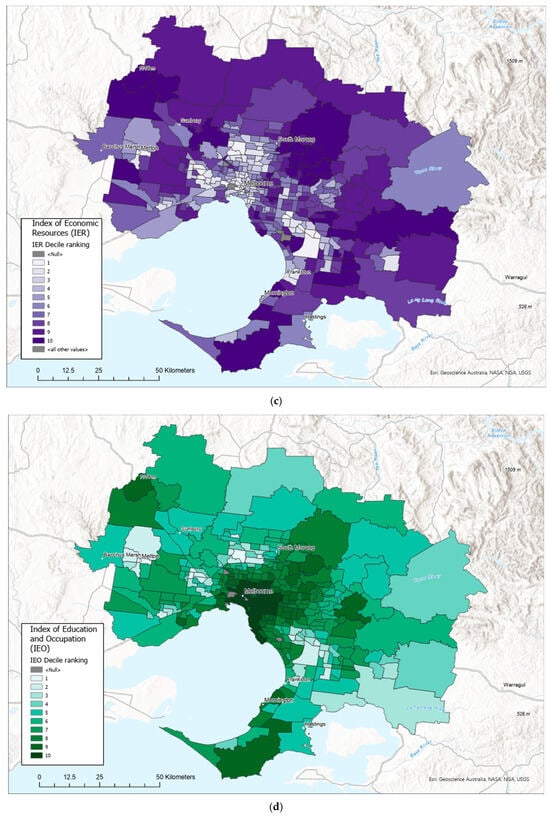
Figure 5.
Digitalised maps based on SEIFA Census 2021 presented in Statistical Area Level 2 (SA2). (a) IRSD decile ranking; (b) IRSAD decile ranking; (c) IER decile ranking; (d) IEO decile ranking.
3. Results
Based on the satellite data extracted from 8 January 2021 and 18 February 2021, then using the geoprocessing method with the Mosaic data management tool in ArcGIS Pro software, a set of raster images were generated in Figure 6. The NDVI created by the Band 4 and Band 5 data shows the highest value of 0.662 and the lowest value of −0.413, with an average value of 0.275. The areas with the lowest value are water bodies under the service and utility planning zone, such as rivers, water reservoirs, and wastewater treatment wetlands. Areas with the highest values are the public park and recreation zone scattered around the CBD, and the surrounding mountain range in the northeast under the green wedge planning zone.
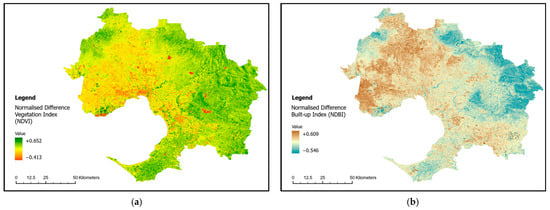
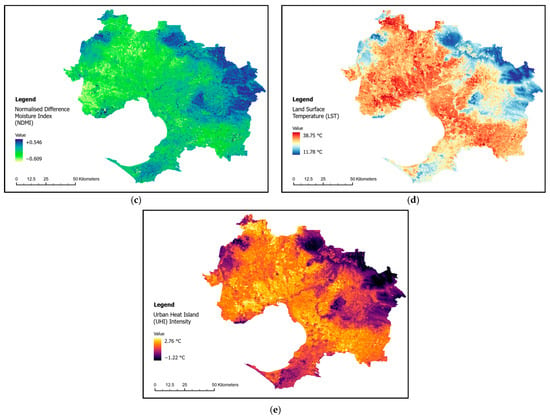
Figure 6.
Geospatial analysis using ArcGIS based on the Landsat 8 raster image data in 1:750,000 scale: (a) NDVI; (b) NDBI; (c) NDMI; (d) LST; (e) UHI.
The NDBI is calculated from Band 5 and Band 6. The highest value of the NDBI is 0.609, and −0.546 is the lowest value. Areas with higher values are mainly located in the west and the northwest, which are outside the urban growth boundary and the CBD area has a relatively lower NDBI value. Opposite to the NDVI, the low values of the NDBI are distributed across the mountain range in the northeast. The maximum LST can reach 38.75 °C, and the minimum LST is 11.78 °C, with a mean LST of 23.74 °C and a standard deviation of 3.94. The calculation of the UHI intensity is based on the LST values, which show the area with the highest UHI intensity of 2.76 °C and the lowest UHI intensity of −1.22 °C.
Overall, the satellite images have shown a consistent pattern between the NDVI, NDBI, LST, and the UHI. When the area has a higher NDVI and NDMI value, the NDBI, LST, and UHI intensity generally have lower values; typical areas with such patterns included the Mount Dandenong and Yarra Range region located in the northeast, the Macedon Ranges on the edge of the northwest, and the tips of the Mornington Peninsula at the south.
3.1. Digitalised Maps Integrated with Satellite Data in Statistical Area Level 2
In order to conduct the correlation analysis with the 2021 Census presented in Statistical Area Level 2, these satellite data have to convert the digital values from raster images into digitised maps that align with the SA2 definition. The ArcGIS Pro software allows turning the digital values of each raster image into individual points, then joining those points that overlay with the corresponding SA2 area to provide an average value within that area. The digitalised maps are illustrated in Figure 7, where each parameter is divided into 10 different value ranges in equal intervals with a graduated colour scheme.
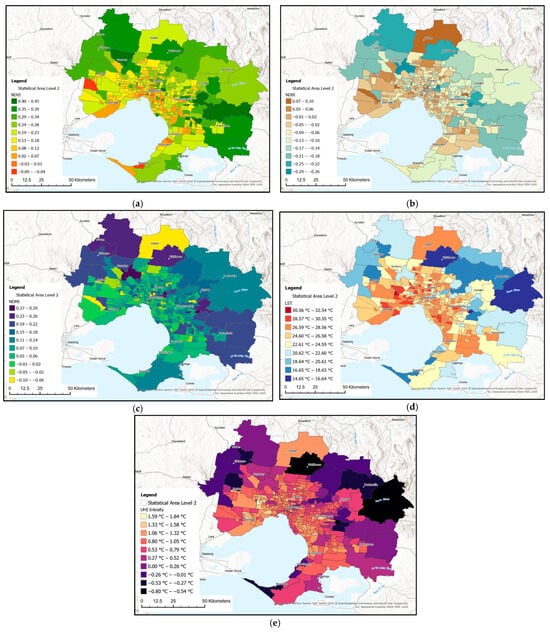
Figure 7.
Digitalised maps in SA2: (a) NDVI; (b) NDBI; (c) NDMI; (d) LST; (e) UHI.
From the NDVI map in Figure 7a, the areas with the reddish colour represent a lower NDVI value, and the areas with green represent a higher NDVI value. The lowest NDVI value recorded in the Rosebud and McCrae areas under the Mornington Peninsula city council, also the Eynesbury and Exford areas under the Melton city council, have a negative NDVI value at −0.09. The area with the highest NDVI value is Sunbury under the Hume city council with a value of 0.45.
From the NDBI map in Figure 7b, the low NDBI value areas are highlighted with cyan colour, and areas with a higher NDBI are highlighted with brown. The Upwey and Tecoma areas within the Yarra Range city council have the lowest NDBI with a negative value of −0.29. The area with the highest NDBI is Northcote East, with the value 0.1. In Figure 7c, the NDMI map, areas with deep blue represent higher NDMI values and the areas in bright yellow represent lower NDMI values. The highest NDMI area is the Upwey—Tecoma, with an NDBI value of 0.29, and the lowest NDMI value is at Northcote East, with the value at −0.1.
In Figure 7d, the LST map illustrates the cool areas in blue colour and the hot areas in red. The area with the highest LST is Deer Park in Melton city council with 32.54 °C, while Yarra Valley in Yarra Range city council has the lowest LST at 14.65 °C. Similar results are demonstrated in Figure 7e, as Deer Park has the highest UHI at 1.84 °C with bright colour, while Yarra Valley is shaded in dark with the lowest UHI at −0.8 °C.
3.2. Correlation Analysis Between Landsat 8 Satellite Data and Socio-Economic Factors
The correlation analysis of the relationship between the Landsat 8 satellite data and the socio-economic factors within the Greater Melbourne Metropolitan region contains 361 suburb areas (n = 361). The results are visualised using the scatter plot matrix tool based on the linear regression model in ArcGIS Pro software, which is able to calculate the R-squared (R2) and Pearson’s correlation coefficient (r) to explore the spatial relationship between individual factors. The Pearson’s correlation coefficient is a scale measurement that varies from +1 to −1, with the value of +1 indicating a strong positive correlation, and vice versa. When the value is zero, it means there is no correlation [55]. R-squared is the coefficient of determination with positive intervals from 0 to 1, with a value R2 =1 indicating a perfect linear relationship between the dependent variable and the independent variables [55]. Figure 8 summarises both the R-squared and Pearson’s correlation coefficient in a matrix diagram. The top right of the matrix provides the values of R-squared, which help to understand the extent of variance of a variable. The values in the bottom left of the matrix are the Pearson’s correlation coefficient (r) that helps to understand the relationship strength between the dependent variable and the independent variables.
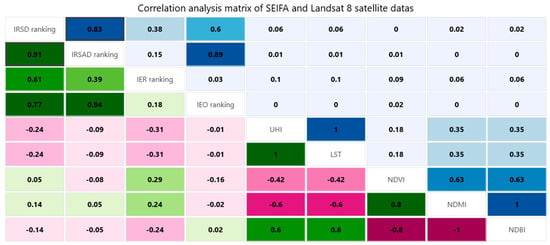
Figure 8.
Correlation analysis between SEIFA and Landsat 8 satellite data. The value in the lower left is the Pearson’s correlation coefficient (r), with the colour scheme that greens represent a positive correlation and pink-purple represents negative correlations. The value on the upper right is the R-squared (R2) linear regression, with the colour scheme that dark blue represents a stronger linear relationship than the light blue.
From Figure 8, it is easy to see that the IRSD has a strong positive correlation to the IRSAD, IER, and IEO, with r = 0.91, 0.61, and 0.77, respectively. The SEIFA indexes with the weakest correlation are the IER and IEO ranking (r = 0.18, R2 = 0.03). When analysing the dependents of SEIFA on the UHI, LST, NDVI, NDMI, and NDBI, most of the results show a negative correlation. Only the NDBI and NDVI results show a positive correlation. The NDBI has an insignificant positive correlation with the IEO ranking (r = 0.02). There are slightly better results on the NDVI, which has a positive correlation with the IRSD ranking (r = 0.05) and IER ranking (r = 0.29).
Among all SEIFA indexes, only the IER ranking has a better correlation with the Landsat 8 satellite data, which has a positive correlation with the NDVI (r = 0.29) and NDMI (r = 0.24), and a negative correlation with the UHI (r = −0.31), LST (r = −0.31), and NDBI (r = −0.24). Compared to the Pearson’s correlation coefficient, the R-squared values between the SEIFA and Landsat 8 satellite data are relatively insignificant, with R2 < 0.2.
Table 3 below lists the top twenty areas that have the highest UHI and LST across the Greater Melbourne region. Deer Park has the highest value of LST at 32.54 °C and UHI at 1.84 °C. Out of these areas, thirteen of them are considered as western suburbs, with five under Brimbank city council, three under Wyndham city council, three under Melton city council, and two under Maribyrnong city council. Most of these areas have an average ranking less than 5; only eight out of twelve areas have an average ranking higher than 5, and the total average ranking of these areas is 4.35 out of the 10-decile ranking system.

Table 3.
Top 20 areas with the highest LST and UHI values.
On the other hand, Table 4 shows the top twenty areas within the Greater Melbourne region with the lower LST and UHI values. Yarra Valley has the lowest value of LST at 16.65 °C and UHI at −0.8 °C. In contrast to the previous result in Table 3, there are only two areas identified as western suburbs; also, only two areas have an average ranking lower than 5, which are Yarra Valley and cover Kurunjang—Toolern Vale. The total average ranking of these twenty areas is 7.59 out of 10 based on the decile ranking system.

Table 4.
Top 20 areas with the lowest LST and UHI values.
These results show that the western suburbs have a higher risk under extreme heat events with a relatively high LST and UHI in comparison to the suburbs in the east and south. At the same time, the average ranking value provides some insights into the vulnerability of the lower-ranking areas that are more exposed to extreme heat than areas with higher rankings.
4. Discussion
The correlation analysis on socio-economic factors using the SEIFA is more effective when analysing the residential or dominant residential areas, due to the indexes being based on the census of population and household; hence, some of the commercial and industrial areas might result in a null value that cannot be used for the correlation analysis.
The visualisation at the statistical area level might not accurately reflect the exact UHI and LST values in raster images, especially areas with complex urban morphology or diverse landscapes. For example, in Figure 9, the raster image indicated the LST within the highlighted zone within the Port of Melbourne can reach as high as 37 °C, as the area contains a large area of concrete foundation and steel containers; however, the water body only has an LST of 18 °C. When these raster image data are processed with the digitalised map using the SA2 definition, they only consider the average LST within that zone, which is 25.66 °C. Therefore, the raster satellite image resulted in a relatively high LST; however, in the digitalised map, the Port of Melbourne would indicate a lower LST compared to the surrounding areas. To achieve a more accurate visualisation that reflects the satellite image data, the SA1 can be used for further divisions in individual areas compared to the SA2; the downside of using the SA1, however, is a larger amount of data will be required to be processed by the ArcGIS Pro software; hence, it might require a computer with a higher capacity and longer time when processing the calculations.
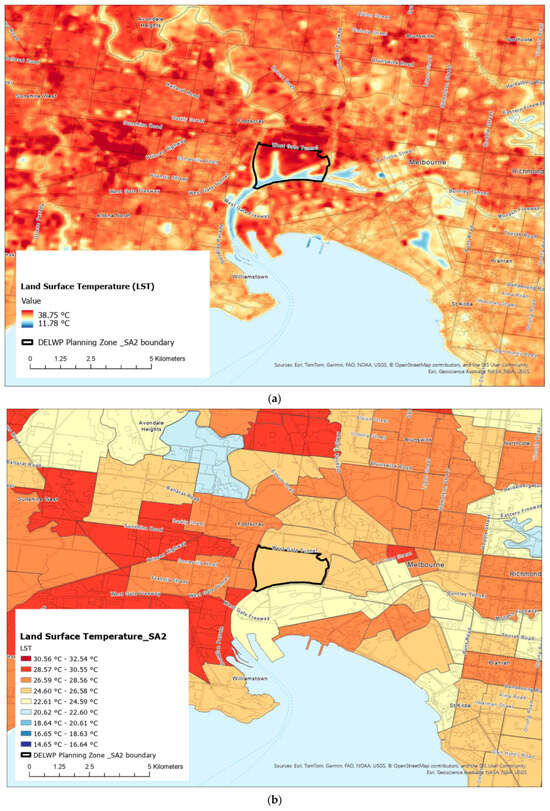
Figure 9.
Illustrations of LST over the port zone in West Melbourne between 10 AM and 11 AM demonstrate the difference between the (a) satellite images on a 1:75,000 scale in comparison to (b) the digitised map based on the SA2 on a 1:75,000 scale.
On the other hand, some hot spot areas are more suitable to analyse with local data instead of macro analysis using the raster satellite images. For example, Figure 10a,b are two sets of satellite images showing the two different industrial zones: one located in the western suburbs covering the area of Rockbank, Truganina, and Derrimut; the other located in the southeast suburbs covering the areas of Keysborough, Dandenong, and Carrum Downs. The NDVI image in Figure 10c,d shows low vegetation in the areas in reddish colour, and it should result in a high LST based on the correlation analysis. However, the LST image in Figure 10e,f shows the measurements are significantly lower, which contradicts the current results.
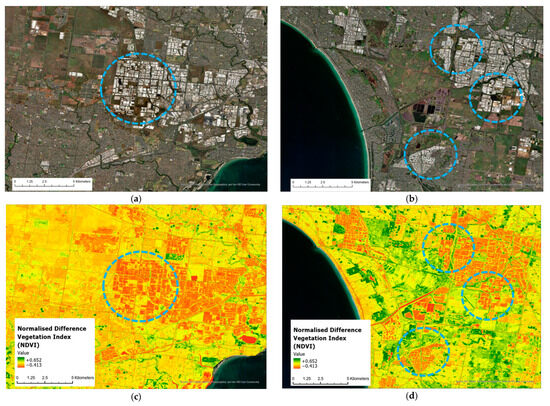
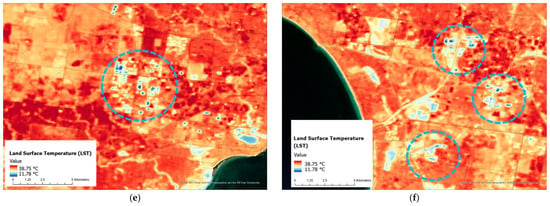
Figure 10.
Satellite images on a 1:75,000 scale that highlight areas (in blue circle) with contradicted results between the LST and NDVI over the industrial zone in the western suburbs (left column) and the southeast suburbs (right column). (a) Represented the industrial zone in the western suburbs. (b) Represented the industrial zones in the eastern suburbs. (c,d) Illustrated the low values of NDVI within the blue circles. (e,f) are the highlighted specific spots within the blue circles with lower LST values.
This might be because in this industrial zone, many warehouses and factories have used high-reflectance rooftop materials, such as cool roof coating and high albedo treatments, that can reflect most of the solar radiation wavelengths [56]. The use of cool roofs can potentially reduce the surface temperature from 13.2% up to 53.6% [57]. Hence, it might explain the reason for the contradictory results in the industrial zone, especially the white-coloured rooftops that are visible on the satellite image shown in Figure 10a,b. However, a more in-depth and comprehensive investigation into the individual building materials in this region is needed to further support this assumption.
Limitations
Although the combination of remote sensing and GIS is very powerful in conducting macro-city-scale analysis and provides correlation analysis, there are a few limitations that might impact the result analysis:
- The availability of satellite images is limited to the date range starting from 2021/01/01 to 2021/12/31 to match with the dataset from the 2021 Census, with the condition of cloud cover range restricted to a maximum of 2%, which largely reduces the available Landsat 8 satellite images that cover the same path and row orbits. As the satellite orbit did not cover the entire study area on the same day, this study uses the geoprocessing tool in ArcGIS Pro to merge satellite images from two different dates into one single image.
- The UHI intensity used in this study is based on land surface temperatures only due to the lack of weather stations to provide sufficient localised data for air temperature across the region on this scale. Therefore, the UHI intensity value can only identify surface urban heat islands and is not able to provide atmospheric UHI calculated by the near-surface air temperature; hence, the result might not be able to emphasise the impact of microclimate characteristics, such as the wind velocity and relative humidity.
- Although satellites are hardly affected by the weather conditions on Earth directly, certain weather conditions would reduce the accuracy of the remote sensing instruments, particularly the cloud density, smoke, fog, and snow that can reflect, refract, or diffuse electromagnetic waves.
- The function of the original Department of Environment, Land, Water and Planning (DELWP) has differentiated into two different departments: The Department of Energy, Environment and Climate Action (DEECA) established in 2023, which focuses on the environment, energy, water, and climate actions aspect of Victoria state; and the Department of Transport and Planning, which focus on planning functions. These changes might affect the future policy makings that relate to the planning zone scheme used in this study.
- The correlation analysis conducted in this study used the default scatter plot matrix chart tool within the ArcGIS Pro software, which provides basic and quick correlation analysis based on simple linear regression models, but limited functions to adjust the formula for better interpretation of the dataset.
- This study focused on the NDVI to determine the vegetation coverage and plant health based on the Landsat 8 images, which did not provide enough information on different vegetation types, such as grassland, shrub, and tree canopies, that have different plant heights and evapotranspiration rates that impact the UHI effect. This study is focused on the macro-city-scale analysis, which limits the ability to track individual heat sources across the city, such as power plants and hospitals.
5. Conclusions and Recommendations
Melbourne is one of the fastest-growing capital cities in Australia, with high demand for housing to accommodate the growing population. The change in land use with increased urban density will escalate the UHI effect. Despite increased awareness and growing interest from local government and developers in integrating urban blue-green infrastructure to mitigate the risk of the UHI, accessibility to green spaces is not distributed equally, and communities with socio-economic disadvantages usually have limited accessibility. Using remote sensing with satellite data and ArcGIS software, this macro-scale study analyses the UHI intensity, LST, and NDVI in the Greater Melbourne region during a summer day in 2021. The results from the Landsat 8 satellite images successfully identified the area with the highest LST and UHI intensity, which is the suburb of Deer Park within the Melton city council located in the west of metropolitan Melbourne. The LST in Deer Park was 32.54 °C, and the UHI intensity was 1.84 °C higher than the average. At the same time, Deer Park also has a low SEIFA ranking, with an IRSD decile ranking of 1, an IRSAD decile ranking of 2, and IER and IEO decile rankings of 3.
Overall, the result of this study shows that both the LST and UHI intensity have a strong negative correlation with the NDVI and NDMI, with a correlation coefficient of r = −0.42 and r = −0.6. This suggests that areas with less water stress also experience more vegetation coverage, experience less severe UHI intensity, and lower LST, reducing the heat burden on residents. At the same time, the NDVI and NDMI have a positive correlation with the Index of Economic Resources (IER) decile ranking with correlation coefficients of r = 0.29 and r = 0.24. This indicates that the areas with better financial resources have higher vegetation coverage or better plant health with higher moisture levels, hence a lower LST and UHI intensity. The results of the R-squared values between the SEIFA indexes and Landsat 8 satellite data might indicate that the simple linear regression model is not the most suitable statistical model for complex spatial analysis, which encourages us to explore other regression models in future analysis, such as geographically weighted regression, ordinary least squares, and exploratory regression. Other statistical analysis software can also be explored to provide alternative interpretations of the dataset, such as MATLAB R2024b, SPSS Statistics 30.0.0, and R-Studio (version 2024.12.1+563). At the same time, when focusing on areas with a significantly high UHI and LST in the Greater Melbourne region, it shows that suburbs located in the west of Melbourne have a higher possibility of experiencing the risk of urban heat, which also have lower SEIFA rankings compared to the suburbs in the south and east. There are two areas that show exemptions to these results, namely the industrial zones located in the west and southeast suburbs, with the satellite imagery showing a significantly low LST on some buildings, likely due to cool roof coatings or high-reflectance treatments on the rooftops, which help reduce solar radiation and LST.
It is recommended to observe the consistency of correlation over time. Conducting the analysis using the latest satellite images, after the release of new SEIFA data following the 2026 Census in Australia, would be beneficial. Since the ABS Census for SEIFA is conducted every five years, the available satellite images might not completely reflect the current demography and socio-economic status of the neighbourhoods. The change in tree canopy and urban forests should also be taken into account in future studies, as increasing the tree canopy is considered one of the most effective ways to mitigate urban heat island effects at the pedestrian level with relatively low cost. Further investigation into the atmospheric urban heat island is also recommended when sufficient air temperature data can be collected from localised weather stations. Some factors, such as human thermal comfort measured by the physiological equivalent temperature (PET) or universal thermal comfort index (UTCI), or the health condition of different demographic groups, may have a stronger relationship with atmospheric urban heat islands. These factors might not be accurately reflected by the land surface temperature measured from the satellite that focuses on the electromagnetic wavelength. The methodology of this study can be further explored across other Australian capital cities with different climate zones and seasons, which will provide a better understanding of how the geographical characteristics influence the vegetation conditions and UHI intensity.
Ultimately, the future UHI intensity patterns in different cities can be calculated by defining urban areas based on urban growth rates. This macro-scale analysis approach can support the creation of different urban development scenarios for predicting and forecasting, helping local city councils to implement flexible urban planning and develop effective strategies to mitigate the risk of urban heat for vulnerable communities.
Author Contributions
Conceptualisation, C.Y.W., M.A.U.R.T. and N.M.; data curation, C.Y.W. and M.A.U.R.T.; formal analysis, C.Y.W. and N.M.; investigation, M.A.U.R.T. and C.Y.W.; methodology, C.Y.W. and N.M.; software, C.Y.W., M.A.U.R.T. and H.-W.C.; supervision, M.A.U.R.T., H.-W.C. and N.M.; validation, H.-W.C. and N.M.; visualisation, C.Y.W. and M.A.U.R.T.; writing—original draft, M.A.U.R.T. and C.Y.W.; writing—review and editing, H.-W.C. and N.M. All authors have read and agreed to the published version of the manuscript.
Funding
This research received no external funding.
Data Availability Statement
The data presented in this study are available on request from the corresponding author.
Acknowledgments
The authors are grateful to the Australia Bureau of Statistics (ABS), the Department of Environment, Land, Water and Planning (DELWP), and the United States Geological Survey (USGS) for supplying the necessary raw data for this research.
Conflicts of Interest
The authors declare no conflicts of interest.
References
- Roser, M.; Rodés-Guirao, L. Future Population Growth. Our World in Data. 2013. Available online: https://ourworldindata.org/future-population-growth (accessed on 8 November 2022).
- Ritchie, H.; Roser, M. Urbanization. Our World in Data. 2018. Available online: https://ourworldindata.org/urbanization (accessed on 8 November 2022).
- Rydlewski, J.; Rajabi, Z.; Tariq, M.A.; Muttil, N.; Sidiqui, P.; Shah, A.A.; Khan, N.A.; Irshad, M.; Alam, A.; Butt, T.A.; et al. Identification of Embodied Environmental Attributes of Construction in Metropolitan and Growth Region of Melbourne, Australia to Support Urban Planning. Sustainability 2022, 14, 8401. [Google Scholar] [CrossRef]
- NHFIC Research. State of the Nation’s Housing 2022–2023. Sydney. 2020. Available online: https://www.housingaustralia.gov.au/sites/default/files/2023-03/state_of_the_nations_housing_report_2022-23.pdf (accessed on 16 July 2024).
- ABS. Capital City Growth the Highest on Record. Australia Bureau of Statistics. 2024. Available online: https://www.abs.gov.au/media-centre/media-releases/capital-city-growth-highest-record (accessed on 12 January 2025).
- Jim, C.Y.; Chen, S.S. Comprehensive greenspace planning based on landscape ecology principles in compact Nanjing city, China. Landsc. Urban Plan. 2003, 65, 95–116. [Google Scholar] [CrossRef]
- Ahmad, T.; Aibinu, A.; Thaheem, M.J. The Effects of High-rise Residential Construction on Sustainability of Housing Systems. Procedia Eng. 2017, 180, 1695–1704. [Google Scholar] [CrossRef]
- Stewart, I.D.; Oke, T.R. Local Climate Zones for Urban Temperature Studies. Bull. Am. Meteorol. Soc. 2012, 93, 1879–1900. [Google Scholar] [CrossRef]
- Yang, L.; Yan, H.; Lam, J.C. Thermal comfort and building energy consumption implications—A review. Appl. Energy 2014, 115, 164–173. [Google Scholar] [CrossRef]
- Luo, X.; Vahmani, P.; Hong, T.; Jones, A. City-Scale Building Anthropogenic Heating during Heat Waves. Atmosphere 2020, 11, 1206. [Google Scholar] [CrossRef]
- Convertino, F.; Vox, G.; Schettini, E. Evaluation of the cooling effect provided by a green façade as nature-based system for buildings. Build. Environ. 2021, 203, 108099. [Google Scholar] [CrossRef]
- Andric, I.; Kamal, A.; Al-Ghamdi, S.G. Efficiency of green roofs and green walls as climate change mitigation measures in extremely hot and dry climate: Case study of Qatar. Energy Rep. 2020, 6, 2476–2489. [Google Scholar] [CrossRef]
- Evola, G.; Costanzo, V.; Magrì, C.; Margani, G.; Marletta, L.; Naboni, E. A novel comprehensive workflow for modelling outdoor thermal comfort and energy demand in urban canyons: Results and critical issues. Energy Build. 2020, 216, 109946. [Google Scholar] [CrossRef]
- Pearsall, H. Staying cool in the compact city: Vacant land and urban heating in Philadelphia, Pennsylvania. Appl. Geogr. 2017, 79, 84–92. [Google Scholar] [CrossRef]
- Dandou, A.; Papangelis, G.; Kontos, Τ.; Santamouris, M.; Tombrou, M. On the cooling potential of urban heating mitigation technologies in a coastal temperate city. Landsc. Urban Plan. 2021, 212, 104106. [Google Scholar] [CrossRef]
- Obiefuna, J.N.; Okolie, C.J.; Nwilo, P.C.; Daramola, O.E.; Isiofia, L.C. Potential Influence of Urban Sprawl and Changing Land Surface Temperature on Outdoor Thermal Comfort in Lagos State, Nigeria. Quaest. Geogr. 2021, 40, 5–23. [Google Scholar] [CrossRef]
- Balany, F.; Ng, A.W.M.; Muttil, N.; Muthukumaran, S.; Wong, M.S. Green infrastructure as an urban heat island mitigation strategy—A review. Water 2020, 12, 3577. [Google Scholar] [CrossRef]
- Norouzi, M.; Chau, H.-W.; Jamei, E. Design and Site-Related Factors Impacting the Cooling Performance of Urban Parks in Different Climate Zones: A Systematic Review. Land 2024, 13, 2175. [Google Scholar] [CrossRef]
- Chen, Y.; Yue, W.; La Rosa, D. Which communities have better accessibility to green space? An investigation into environmental inequality using big data. Landsc. Urban Plan. 2020, 204, 103919. [Google Scholar] [CrossRef]
- Sarricolea, P.; Smith, P.; Romero-Aravena, H.; Serrano-Notivoli, R.; Fuentealba, M.; Meseguer-Ruiz, O. Socioeconomic inequalities and the surface heat island distribution in Santiago, Chile. Sci. Total Environ. 2022, 832, 155152. [Google Scholar] [CrossRef]
- Astell-Burt, T.; Feng, X.; Mavoa, S.; Badland, H.M.; Giles-Corti, B. Do low-income neighbourhoods have the least green space? A cross-sectional study of Australia’s most populous cities. BMC Public Health 2014, 14, 292. [Google Scholar] [CrossRef]
- Vidal, D.G.; Fernandes, C.O.; Viterbo, L.M.F.; Vilaça, H.; Barros, N.; Maia, R.L. Combining an evaluation grid application to assess ecosystem services of urban green spaces and a socioeconomic spatial analysis. Int. J. Sustain. Dev. World Ecol. 2021, 28, 291–302. [Google Scholar] [CrossRef]
- Cheshmehzangi, A.; Butters, C.; Xie, L.; Dawodu, A. Green infrastructures for urban sustainability: Issues, implications, and solutions for underdeveloped areas. Urban For. Urban Green. 2021, 59, 127028. [Google Scholar] [CrossRef]
- Saverino, K.C.; Routman, E.; Lookingbill, T.R.; Eanes, A.M.; Hoffman, J.S.; Bao, R. Thermal Inequity in Richmond, VA: The Effect of an Unjust Evolution of the Urban Landscape on Urban Heat Islands. Sustainability 2021, 13, 1511. [Google Scholar] [CrossRef]
- Lo, A.Y.; Jim, C.Y.; Cheung, P.K.; Wong, G.K.L.; Cheung, L.T.O. Space poverty driving heat stress vulnerability and the adaptive strategy of visiting urban parks. Cities 2022, 127, 103740. [Google Scholar] [CrossRef]
- Mushore, T.D.; Mutanga, O.; Odindi, J.; Dube, T. Determining extreme heat vulnerability of Harare Metropolitan City using multispectral remote sensing and socio-economic data. J. Spat. Sci. 2018, 63, 173–191. [Google Scholar] [CrossRef]
- Luo, M.; Wang, Z.; Ke, K.; Cao, B.; Zhai, Y.; Zhou, X. Human metabolic rate and thermal comfort in buildings: The problem and challenge. Build. Environ. 2018, 131, 44–52. [Google Scholar] [CrossRef]
- Jesdale, B.M.; Morello-Frosch, R.; Cushing, L. The Racial/Ethnic Distribution of Heat Risk–Related Land Cover in Relation to Residential Segregation. Environ. Health Perspect. 2013, 121, 811–817. [Google Scholar] [CrossRef] [PubMed]
- Mushangwe, S.; Astell-Burt, T.; Steel, D.; Feng, X. Ethnic inequalities in green space availability: Evidence from Australia. Urban For. Urban Green. 2021, 64, 127235. [Google Scholar] [CrossRef]
- Wai, C.Y.; Muttil, N.; Tariq, M.A.U.R.; Paresi, P.; Nnachi, R.C.; Ng, A.W.M. Investigating the Relationship between Human Activity and the Urban Heat Island Effect in Melbourne and Four Other International Cities Impacted by COVID-19. Sustainability 2022, 14, 378. [Google Scholar] [CrossRef]
- Kim, S.W.; Brown, R.D. Urban heat island (UHI) intensity and magnitude estimations: A systematic literature review. Sci. Total Environ. 2021, 779, 146389. [Google Scholar] [CrossRef]
- Wai, C.Y.; Tariq, M.A.U.R.; Muttil, N. A Systematic Review on the Existing Research, Practices, and Prospects Regarding Urban Green Infrastructure for Thermal Comfort in a High-Density Urban Context. Water 2022, 14, 2496. [Google Scholar] [CrossRef]
- Macarof, P.; Florian, S. Comparasion of NDBI and NDVI as Indicators of Surface Urban Heat Island Effect in Landsat 8 Imagery: A Case Study of Iasi. Present Environ. Sustain. Dev. 2017, 11, 141–150. [Google Scholar] [CrossRef]
- Florim, I.; Albert, B.; Shpejtim, B. Measuring UHI using Landsat 8 OLI and TIRS data with NDVI and NDBI in Municipality of Prishtina. Disaster Adv. 2021, 14, 25–36. [Google Scholar] [CrossRef]
- Sresto, M.A.; Morshed, M.M.; Siddika, S.; Almohamad, H.; Al-Mutiry, M.; Abdo, H.G. Impact of COVID-19 Lockdown on Vegetation Indices and Heat Island Effect: A Remote Sensing Study of Dhaka City, Bangladesh. Sustainability 2022, 14, 7922. [Google Scholar] [CrossRef]
- Landsat Missions Normalized Difference Moisture Index. USGS. 2025. Available online: https://www.usgs.gov/landsat-missions/normalized-difference-moisture-index (accessed on 1 April 2025).
- Nakata-Osaki, C.M.; Souza, L.C.L.; Rodrigues, D.S. THIS—Tool for Heat Island Simulation: A GIS extension model to calculate urban heat island intensity based on urban geometry. Comput. Environ. Urban Syst. 2018, 67, 157–168. [Google Scholar] [CrossRef]
- Gallacher, C.; Benz, S.; Boehnke, D.; Jehling, M. A collaborative approach for the identification of thermal hot-spots: From remote sensing data to urban planning interventions. Agil. GISci. Ser. 2024, 5, 23. [Google Scholar] [CrossRef]
- Sun, Y.; Li, Y.; Ma, R.; Gao, C.; Wu, Y. Mapping urban socio-economic vulnerability related to heat risk: A grid-based assessment framework by combing the geospatial big data. Urban Clim. 2022, 43, 101169. [Google Scholar] [CrossRef]
- Viju, T.; Nambiar, A.; Firoz, C.M. Chapter 8—Sustainable land management strategies, drivers of LULC change and degradation: An assessment of Malappuram Metropolitan region, Kerala, India. In Science of Sustainable Systems; Chatterjee, U., Pradhan, B., Kumar, S., Saha, S., Zakwan, M., Fath, B.D., Fiscus, D., Eds.; Water, Land, and Forest Susceptibility and Sustainability; Academic Press: Cambridge, MA, USA, 2023; Volume 2, pp. 191–214. [Google Scholar]
- Imtiaz, F.; Farooque, A.A.; Randhawa, G.S.; Wang, X.; Esau, T.J.; Acharya, B.; Hashemi Garmdareh, S.E. An inclusive approach to crop soil moisture estimation: Leveraging satellite thermal infrared bands and vegetation indices on Google Earth engine. Agric. Water Manag. 2024, 306, 109172. [Google Scholar] [CrossRef]
- Sidiqui, P.; Tariq, M.A.; Ng, A.W.M. An Investigation to Identify the Effectiveness of Socioeconomic, Demographic, and Buildings’ Characteristics on Surface Urban Heat Island Patterns. Sustainability 2022, 14, 2777. [Google Scholar] [CrossRef]
- Sun, C.; Hurley, J.; Amati, M.; Arundel, J.; Saunders, A.; Boruff, B.; Caccetta, P. Urban Vegetation, Urban Heat Islands and Heat Vulnerability Assessment in Melbourne. 2018. Available online: https://www.planning.vic.gov.au/__data/assets/pdf_file/0032/655826/UHI-and-HVI2018_Report_v1.pdf (accessed on 30 October 2024).
- Sharifi, F.; Nygaard, A.; Stone, W.M.; Levin, I. Accessing green space in Melbourne: Measuring inequity and household mobility. Landsc. Urban Plan. 2021, 207, 104004. [Google Scholar] [CrossRef]
- ABS Regional Population: Statistics About the Population and Components of Change (Births, Deaths, Migration) for Australia’s Capital Cities and Regions. Australia Bureau of Statistics. 2024. Available online: https://www.abs.gov.au/statistics/people/population/regional-population/2022-23 (accessed on 12 January 2025).
- USGS. EarthExplorer. 2024. Available online: https://earthexplorer.usgs.gov/ (accessed on 3 January 2024).
- Arnfield, A.J. Köppen Climate Classification. Encyclopedia Britannica. 11 November 2020. Available online: https://www.britannica.com/science/Koppen-climate-classification (accessed on 11 April 2021).
- NASA. LANDSAT 8. National Aeronautics and Space Administration. 2024. Available online: https://landsat.gsfc.nasa.gov/satellites/landsat-8/ (accessed on 13 May 2024).
- Shukla, G.; Tiwari, P.; Dugesar, V.; Srivastava, P.K. Chapter 9—Estimation of evapotranspiration using surface energy balance system and satellite datasets. In Agricultural Water Management; Srivastava, P.K., Gupta, M., Tsakiris, G., Quinn, N.W., Eds.; Academic Press: Cambridge, MA, USA, 2021; pp. 157–183. [Google Scholar]
- USGS. Landsat 8 Data Users Handbook 2019; Landsat Project Science Office: Sioux Falls, SD, USA, 2019; Available online: https://d9-wret.s3.us-west-2.amazonaws.com/assets/palladium/production/s3fs-public/atoms/files/LSDS-1574_L8_Data_Users_Handbook-v5.0.pdf (accessed on 10 March 2024).
- Avdan, U.; Jovanovska, G. Algorithm for Automated Mapping of Land Surface Temperature Using LANDSAT 8 Satellite Data. J. Sens. 2016, 2016, 1480307. [Google Scholar] [CrossRef]
- Gao, B. NDWI—A normalized difference water index for remote sensing of vegetation liquid water from space. Remote Sens. Environ. 1996, 58, 257–266. [Google Scholar] [CrossRef]
- Australian Bureau of Statistics. Socio-Economic Indexes for Areas (SEIFA), Australia. ABS. 2023. Available online: https://www.abs.gov.au/statistics/people/people-and-communities/socio-economic-indexes-areas-seifa-australia/latest-release (accessed on 1 May 2024).
- ABS. Socio-Economic Indexes for Areas (SEIFA), Australia Methodology. Australia Bureau of Statistics. 2023. Available online: https://www.abs.gov.au/methodologies/socio-economic-indexes-areas-seifa-australia-methodology/2021 (accessed on 13 April 2025).
- Profillidis, V.A.; Botzoris, G.N. Chapter 5—Statistical Methods for Transport Demand Modeling. In Modeling of Transport Demand: Analyzing, Calculating, and Forecasting Transport Demand; Profillidis, V.A., Botzoris, G.N., Eds.; Elsevier: Amsterdam, The Netherlands, 2019; pp. 163–224. [Google Scholar]
- Basyouni, Y.A.; Mahmoud, H. Affordable green materials for developed cool roof applications: A review. Renew. Sustain. Energy Rev. 2024, 202, 114722. [Google Scholar] [CrossRef]
- Wai, C.Y.; Chau, H.-W.; Paresi, P.; Muttil, N. Experimental Analysis of Cool Roof Coatings as an Urban Heat Mitigation Strategy to Enhance Thermal Performance. Buildings 2025, 15, 685. [Google Scholar] [CrossRef]
Disclaimer/Publisher’s Note: The statements, opinions and data contained in all publications are solely those of the individual author(s) and contributor(s) and not of MDPI and/or the editor(s). MDPI and/or the editor(s) disclaim responsibility for any injury to people or property resulting from any ideas, methods, instructions or products referred to in the content. |
© 2025 by the authors. Licensee MDPI, Basel, Switzerland. This article is an open access article distributed under the terms and conditions of the Creative Commons Attribution (CC BY) license (https://creativecommons.org/licenses/by/4.0/).